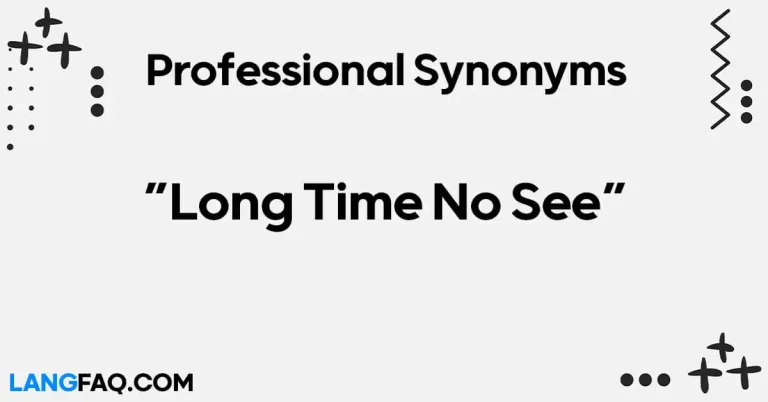Welcome to the linguistic journey where we delve into diverse expressions! If you’ve been curious about different ways to convey “In Case You Are Not Aware,” you’re in for a treat. This article not only expands your vocabulary but also takes you on an engaging exploration of language nuances. So, fasten your seatbelt as we navigate through a plethora of expressive alternatives.
12 Other Ways to Say “In Case You Are Not Aware”
Here are 12 alternative ways to express “In Case You Are Not Aware” in English:
- Just to Let You Know
- For Your Information (FYI)
- Allow Me to Inform You
- To Keep You Updated
- In the Event You Didn’t Know
- To Draw Your Attention
- To Share a Glimpse
- Just a Heads-Up
- To Enlighten You
- For Your Consideration
- To Shed Light On
- To Keep You in the Loop
Here’s a table with the meaning and examples for each alternative expression:
| Expression | Meaning | Examples |
|---|---|---|
| Just to Let You Know | Informing someone of a particular fact. | – Just to let you know, the meeting has been rescheduled. |
| For Your Information (FYI) | Providing information for awareness. | – FYI, there’s a new policy in effect from tomorrow. |
| Allow Me to Inform You | Requesting permission to share information. | – Allow me to inform you about the upcoming changes. |
| To Keep You Updated | Ensuring someone stays informed. | – I’ll send regular emails to keep you updated on the project. |
| In the Event You Didn’t Know | Preparing someone for new information. | – In the event you didn’t know, we have a guest speaker tomorrow. |
| To Draw Your Attention | Redirecting someone’s focus. | – I wanted to draw your attention to the key points in the report. |
| To Share a Glimpse | Offering a brief overview or insight. | – Let me share a glimpse of what the new product can do. |
| Just a Heads-Up | Providing a friendly advance notice. | – Just a heads-up, we’ll have a team meeting at 3 PM. |
| To Enlighten You | Providing knowledge or insight. | – Allow me to enlighten you about the historical significance of this place. |
| For Your Consideration | Suggesting something for thought. | – For your consideration, we propose a new approach to the project. |
| To Shed Light On | Providing clarity or understanding. | – Let me shed light on the reasons behind the decision. |
| To Keep You in the Loop | Keeping someone informed about ongoing events. | – We’ll include you in the loop regarding any project updates. |
This table provides a diverse set of expressions to replace the common phrase “In Case You Are Not Aware.” By incorporating these alternatives into your communication, you can add nuance, politeness, and clarity to your messages. Whether you’re in a professional setting, conveying information, or simply sharing updates, these alternatives offer a range of options to suit various contexts. Elevate your language and captivate your audience with these nuanced and effective expressions.
Is It Correct to Say “In Case You Are Not Aware”?
Yes, “In Case You Are Not Aware” is a grammatically correct sentence. It is a formal and polite way to bring attention to certain information or to ensure that someone is informed about a particular matter. However, for a slightly more natural and concise expression, alternatives like “Just to Let You Know,” “For Your Information (FYI),” or “Allow Me to Inform You” can be used.
The sentence structure “In Case You Are Not Aware” is clear and straightforward, making it suitable for various contexts, including professional communications, formal announcements, or polite reminders. It’s always essential to choose language that aligns with the formality of the situation and the relationship between the speaker and the audience.
Professional Mail Example With “In Case You Are Not Aware”
Subject: Important Update Regarding Project Timeline
Dear [Recipient’s Name],
I trust this email finds you well. I am writing to bring to your attention a critical update regarding the project timeline.
In case you are not aware, recent developments in our project execution strategy have necessitated a slight adjustment to our deadlines. We believe this modification is essential to ensure the successful completion of the project within the highest standards.
The new timeline is as follows:
- Task A: Extended to [New Deadline]
- Task B: Revised to [New Deadline]
- Task C: Adjusted to [New Deadline]
Your collaboration and dedication to the project are highly valued, and we appreciate your understanding in light of these changes.
If you have any questions or require further clarification, please do not hesitate to reach out. We are committed to maintaining transparent communication throughout the project’s lifecycle.
Thank you for your continued commitment to our shared goals.
Best regards,
[Your Full Name]
[Your Position]
[Your Company]
[Contact Information]
Just to Let You Know
In the vast landscape of communication, the phrase “Just to Let You Know” acts as a gentle beacon, guiding the listener to important information. This expression is versatile, fitting seamlessly into both formal and informal contexts, making it a valuable addition to your verbal toolkit.
When and Where to Use:
Formal Context: In professional settings, “Just to Let You Know” serves as a polite preamble to convey essential details. For example, in an email to colleagues about a meeting update:
Dear Team,
Just to let you know, the quarterly review meeting has been rescheduled to 2 PM tomorrow. Your presence is highly appreciated.
Best regards,
[Your Name]
Informal Context: In more casual scenarios, this phrase can be used among friends to share noteworthy information:
Hey, just to let you know, the weekend plans have changed. We’re meeting at the park instead of the coffee shop.
Variations:
- Colleague Relationship: Just wanted to keep you in the loop about the project updates.
- Mentor-Mentee Dynamic: Mentee, just to let you know, your recent contributions to the project are commendable.
Pros and Cons:
Pros:
- Polite and non-intrusive.
- Suitable for various relationships and settings.
Cons:
- May sound slightly formal in very casual conversations.
Dictionary Insight:
Cambridge Dictionary defines “Just to Let You Know” as a phrase used to politely give someone information.
Tips:
Maintain a friendly tone to ensure the phrase doesn’t come across as overly formal. Use it judiciously to convey important, yet non-urgent, details.
For Your Information (FYI)
The acronym FYI, short for “For Your Information,” is a concise and widely recognized way to share information. Its brevity makes it an excellent choice for quick updates or when time is of the essence.
When and Where to Use:
Formal Context: In professional emails or formal communication, FYI adds a touch of efficiency. For instance, in a project update:
Dear Team,
FYI, the client’s feedback has been incorporated into the final proposal. Please review before the meeting.
Best regards,
[Your Name]
Informal Context: Even in casual conversations, FYI fits seamlessly, providing a quick heads-up:
Hey, FYI, the lunch meeting got moved to 1 PM.
Variations:
- Supervisor to Subordinate: Just a quick FYI, the deadline for the report has been extended.
- Among Friends: FYI, the party is at Jake’s place this Friday.
Pros and Cons:
Pros:
- Conveys information succinctly.
- Widely recognized in various contexts.
Cons:
- Might seem a bit abrupt if overused.
Dictionary Insight:
According to Oxford Languages, FYI is an informal abbreviation commonly used in written communication to say that the receiver should know or be informed of something.
Tips:
Reserve FYI for brief, informative messages. Its strength lies in its brevity, so avoid unnecessary elaboration.
Allow Me to Inform You
The phrase “Allow Me to Inform You” brings an air of formality and politeness, making it suitable for situations where a respectful presentation of information is crucial.
When and Where to Use:
Formal Context: This phrase shines in professional correspondence, such as when delivering updates to superiors or colleagues:
Dear [Recipient’s Name],
Allow me to inform you that our team has successfully secured the contract for the upcoming project. Your guidance has been invaluable throughout.
Best regards,
[Your Name]
Informal Context: In more relaxed settings, it can be used to share information without sounding too casual:
Hey, allow me to inform you about the new policy. It’s effective starting next week.
Variations:
- Colleague to Colleague: Colleague, allow me to inform you of the recent changes in the schedule.
- Professional Announcement: Ladies and gentlemen, allow me to inform you of the exciting developments in our company.
Pros and Cons:
Pros:
- Conveys information with formality and respect.
- Ideal for professional announcements.
Cons:
- Might sound overly formal in casual settings.
Dictionary Insight:
Merriam-Webster defines “Allow Me to Inform You” as a polite way of indicating that one is about to give information.
Tips:
Maintain a balance between formality and approachability. Use this phrase when the information carries significance and warrants a certain level of respect.
To Keep You Updated
The expression “To Keep You Updated” not only imparts information but also emphasizes an ongoing flow of communication, fostering a sense of collaboration and shared knowledge.
When and Where to Use:
Formal Context: In a professional environment, using this phrase in project updates or reports ensures everyone stays informed:
Dear Team,
I’d like to keep you updated on the progress of the marketing campaign. Please find the attached report for your review.
Best regards,
[Your Name]
Informal Context: Among friends or in casual workplace conversations, it can denote transparency:
Hey, just wanted to keep you updated on the weekend plans. We’re meeting at the park.
Variations:
- Team Communication: Team, to keep you updated, we’ve surpassed our quarterly targets.
- Friend to Friend: Just a quick call to keep you updated on the latest gossip.
Pros and Cons:
Pros:
- Emphasizes ongoing communication.
- Suitable for both professional and personal contexts.
Cons:
- May sound a bit formal in very casual settings.
Dictionary Insight:
The Cambridge Dictionary defines “Keep Someone Updated” as to make sure someone always knows the most recent information about something.
Tips:
Use this phrase regularly in professional settings to foster an atmosphere of shared knowledge and collaboration. In casual contexts, adjust the tone to maintain a friendly vibe.
In the Event You Didn’t Know
“In the Event You Didn’t Know” carries an element of anticipation, preparing the listener for upcoming information. This expression is both formal and intriguing, making it effective for introducing new or unexpected details.
When and Where to Use:
Formal Context: In business communications or official announcements, this phrase sets the stage for important updates:
Dear All,
In the event you didn’t know, our company has been recognized with the Industry Excellence Award. Congratulations to the entire team!
Best regards,
[Your Name]
Informal Context: When sharing exciting news with friends or family, this phrase adds a touch of flair:
Guess what? In the event you didn’t know, Jake and Sarah are getting married!
Variations:
- Manager to Team: In the event you didn’t know, our quarterly results have surpassed expectations.
- Among Friends: In the event you didn’t know, Sarah is throwing a surprise party for Jake’s birthday.
Pros and Cons:
Pros:
- Creates anticipation for forthcoming information.
- Suitable for both formal and informal announcements.
Cons:
- May sound overly formal in casual conversations.
Dictionary Insight:
Merriam-Webster defines “In the Event Of” as a phrase used to say what will happen if something else occurs.
Tips:
Employ this phrase when unveiling significant news or achievements. Its formality adds weight to the information, making it especially effective in professional contexts.
To Draw Your Attention
“To Draw Your Attention” is a powerful expression that commands focus, making it ideal for situations where specific details need emphasis or clarification.
When and Where to Use:
Formal Context: In professional documents, emails, or reports, this phrase is a courteous way to highlight essential information:
Dear [Recipient’s Name],
I’d like to draw your attention to the crucial points outlined in the contract, specifically Section 3 regarding delivery timelines.
Best regards,
[Your Name]
Informal Context: Even in casual conversations, it can be employed for added emphasis:
Hey, just wanted to draw your attention to the new safety protocols. It’s important that we all follow them.
Variations:
- Team Leader to Team: Team, I’d like to draw your attention to the upcoming changes in our project timeline.
- Among Friends: Guys, draw your attention to the amazing sunset happening right now.
Pros and Cons:
Pros:
- Highlights important details with politeness.
- Suitable for both formal and informal communication.
Cons:
- Might sound overly formal in very casual settings.
Dictionary Insight:
The Oxford English Dictionary defines “To Draw Someone’s Attention” as to attract someone’s notice to something.
Tips:
Use this expression sparingly to underscore critical points. Its formality lends weight to the highlighted information, making it memorable for the reader or listener.
To Share a Glimpse
“To Share a Glimpse” invites others into a moment or insight, making it an engaging expression suitable for both personal anecdotes and professional narratives.
When and Where to Use:
Formal Context: In professional settings, this phrase can be incorporated into presentations or reports to offer a sneak peek or insight:
Ladies and Gentlemen,
Allow me to share a glimpse of our upcoming product launch strategy. This approach promises to revolutionize our market presence.
Best regards,
[Your Name]
Informal Context: Among friends or in casual workplace conversations, it adds a personal touch to storytelling:
Guys, let me share a glimpse of my weekend getaway. The scenery was breathtaking!
Variations:
- Manager to Team: Team, I want to share a glimpse of the exciting projects lined up for the next quarter.
- Friendly Banter: Hey, let me share a glimpse of the hilarious incident that happened at the office party.
Pros and Cons:
Pros:
- Adds a personal touch to communication.
- Engages the audience with a sense of anticipation.
Cons:
- May sound informal in very formal settings.
Dictionary Insight:
Cambridge Dictionary defines “Glimpse” as a brief or quick view or look.
Tips:
Employ this phrase when you want to captivate your audience with a brief, intriguing preview. In formal settings, use it selectively to maintain a professional tone.
Just a Heads-Up
“Just a Heads-Up” is a friendly and casual expression that serves as a gentle alert, making it perfect for informal conversations or friendly notifications.
When and Where to Use:
Formal Context: In professional emails or team communications, this phrase can be used to convey important but non-urgent information:
Dear Team,
Just a heads-up, the deadline for the project has been extended by two days. Take your time for thorough revisions.
Best regards,
[Your Name]
Informal Context: Among friends or in casual workplace discussions, it provides a laid-back way to share information:
Hey, just a heads-up, the cafeteria is closed for renovation this week.
Variations:
- Supervisor to Subordinate: Team, just a heads-up, there’s a change in the schedule for tomorrow’s meeting.
- Friend to Friend: Just a heads-up, I might be a bit late to the party tonight.
Pros and Cons:
Pros:
- Informal and friendly tone.
- Conveys information without sounding alarming.
Cons:
- Might seem too casual in formal or serious contexts.
Dictionary Insight:
The Oxford English Dictionary defines “Heads-Up” as an informal alert or warning.
Tips:
Use “Just a Heads-Up” when you want to inform others in a friendly manner without causing unnecessary concern. It’s effective for maintaining open communication without sounding overly formal.
To Enlighten You
“To Enlighten You” carries a sense of wisdom and insight, making it an ideal expression for sharing knowledge or providing clarifications in a formal or instructive context.
When and Where to Use:
Formal Context: In professional settings, use this phrase to impart information or insights, especially in educational or instructional materials:
Dear Participants,
Allow me to enlighten you about the core principles of our new software. Understanding these will streamline your workflow.
Best regards,
[Your Name]
Informal Context: In casual conversations, it can be employed when sharing interesting or enlightening facts:
Hey, let me enlighten you about the history of this ancient artifact. It’s truly fascinating!
Variations:
- Mentor to Mentee: As your mentor, let me enlighten you about the key strategies for professional growth.
- Among Friends: Guys, let me enlighten you about the best way to navigate through this challenging situation.
Pros and Cons:
Pros:
- Conveys wisdom and knowledge.
- Suitable for both formal and informal settings.
Cons:
- May sound too formal in very casual conversations.
Dictionary Insight:
Merriam-Webster defines “Enlighten” as to furnish knowledge or insight to.
Tips:
Use “To Enlighten You” when you want to share valuable insights or knowledge. In formal contexts, it adds a touch of authority to your communication.
For Your Consideration
“For Your Consideration” is a sophisticated and polite expression, signaling the presentation of information for thoughtful contemplation or decision-making.
When and Where to Use:
Formal Context: In professional emails, proposals, or formal requests, this phrase signals the introduction of ideas or suggestions:
Dear [Recipient’s Name],
For your consideration, I am proposing a revised timeline for the upcoming project. Kindly review and share your feedback at your earliest convenience.
Best regards,
[Your Name]
Informal Context: In more casual discussions where a degree of formality is still required, it can be utilized:
Hey, for your consideration, I suggest we move our weekly catch-up to Friday mornings. What do you think?
Variations:
- Project Team Collaboration: Team, here’s a new strategy for your consideration as we aim to enhance our productivity.
- Among Friends Planning an Event: For your consideration, let’s host the party at Rachel’s place this time.
Pros and Cons:
Pros:
- Polite and formal tone.
- Indicates respect for others’ opinions.
Cons:
- May seem too formal in very casual settings.
Dictionary Insight:
According to Oxford Languages, “For Your Consideration” is a phrase used when asking someone to think about something or take it into account.
Tips:
Use this expression when presenting ideas or suggestions that require thoughtful contemplation. It adds a level of formality and respect to your communication.
To Shed Light On
“To Shed Light On” is a powerful expression that not only informs but also clarifies, bringing understanding and illumination to a topic. This phrase is particularly effective in both formal and educational contexts.
When and Where to Use:
Formal Context: In professional emails, reports, or presentations, use this phrase to provide clarity on complex topics:
Dear Team,
Allow me to shed light on the recent changes in our organizational structure. This restructuring aims to enhance efficiency and collaboration.
Best regards,
[Your Name]
Informal Context: In educational settings or casual discussions, it can be employed to explain or demystify a subject:
Hey, let me shed light on the scientific principles behind this fascinating phenomenon. It’s truly captivating!
Variations:
- Educational Setting: Class, today I’m going to shed light on the historical events that led to the formation of our constitution.
- Friend Explaining a Concept: Let me shed light on why choosing the right software is crucial for our project’s success.
Pros and Cons:
Pros:
- Provides clarity and understanding.
- Suitable for both formal and informal settings.
Cons:
- May sound too formal in very casual conversations.
Dictionary Insight:
The Collins English Dictionary defines “To Shed Light On” as to clarify or supply additional information.
Tips:
Use this expression when you want to offer insights that bring clarity. Its formal undertone suits professional settings, but it can be adapted for educational and casual contexts.
To Keep You in the Loop
“To Keep You in the Loop” is a friendly and inclusive expression, signifying ongoing communication and transparency. This phrase is effective in both professional and personal settings.
When and Where to Use:
Formal Context: In business emails, project updates, or team communications, this phrase fosters transparency and ensures everyone stays informed:
Dear All,
I’d like to keep you in the loop about the upcoming changes to our office policies. Your feedback is valuable in this process.
Best regards,
[Your Name]
Informal Context: In casual conversations or among friends, it conveys a sense of inclusivity:
Hey, just to keep you in the loop, we’re planning a surprise farewell party for Sarah next week.
Variations:
- Manager to Team: Team, I want to keep you in the loop about the progress of our ongoing projects.
- Among Friends Planning an Outing: Just to keep you in the loop, we’re thinking of going hiking this weekend. Are you in?
Pros and Cons:
Pros:
- Fosters transparency and inclusion.
- Suitable for both formal and informal communication.
Cons:
- May sound too casual in very formal settings.
Dictionary Insight:
According to Cambridge Dictionary, “Keep Someone in the Loop” means to keep someone informed about all the facts of a situation.
Tips:
Use this expression regularly in professional settings to foster an atmosphere of shared knowledge. In casual contexts, adjust the tone to maintain a friendly and inclusive vibe.
Frequently Asked Questions (FAQs):
What are some casual alternatives for “In Case You Are Not Aware”?
Casual alternatives include “FYI,” “Just a Heads-Up,” and “P.S.”
How can I make my communication more authoritative when conveying information?
To add authority, consider alternatives like “Allow Me to Clarify” or “Let Me Enlighten You.”
Are there alternatives suitable for formal settings?
Certainly! Phrases like “For Your Consideration” or “Permit Me to Inform You” work well in formal situations.
Can I use these alternatives in written communication?
Absolutely! These alternatives are versatile and can be seamlessly incorporated into both spoken and written communication.
Do these alternatives work in professional environments?
Yes, expressions like “To Keep You Updated” or “For Your Insider Insight” are apt for professional settings, adding a touch of sophistication.
How can I use these alternatives in a friendly conversation?
In a friendly conversation, opt for alternatives like “Just to Bring to Your Attention” or “To Share a Glimpse” for a warm and inclusive tone.
Conclusion:
Congratulations! You’ve now unlocked a treasure trove of expressions to replace the mundane “In Case You Are Not Aware.” Enhance your communication, captivate your audience, and wield the power of language with these alternatives. Language is a dynamic tool—use it with flair!







